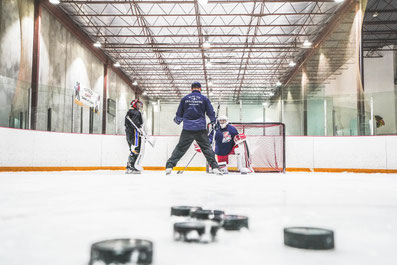Sports Vision

To enhance athletic confidence and performance, excellent visual-motor coordination is essential. Fast reaction times, accurate reaction responses, superb central and peripheral vision, and excellent bilateral visual-motor coordination are important elements of the visual-motor system. These elements can be measured, and can be trained for improvement.
Central Vision versus Peripheral Vision
In normal day to day activities we use our central vision to perform tasks. Our peripheral vision is largely tuned out as unwanted noise. When it comes to sports, the opposite is necessary........the ability to use both central and peripheral vision quickly, accurately and completely is required for you to be able to perform well. For instance, in ice hockey, a player must be able to keep his or her eyes and head up, while skating, and while tracking multiple stationary and moving targets in peripheral vision such as the puck, team mates, opponents, the goalie, and the net.
Testing for Visual-Motor Coordination
It is important that visual-motor coordination is measured before training to gain insight into strengths and weaknesses, and then after training to evaluate for progress. We have developed a very advanced program to evaluate visual-motor coordination for sports. We test for right and left-sided coordination, right and left-eyed coordination, ability to function with suboptimal, interrupted visual input, peripheral vision tracking ability, peripheral vision interpretation ability, multi-tasking coordination, reaction speed and reaction accuracy.
Training for Visual-Motor Coordination
Research shows that visual-motor training increases the density of brain neuron cells and axon connections between neurons. Improved brain neuron structure allows for faster and more efficient neuronal processing to enhance and to improve performance.
With insight into your strengths and weaknesses, training can be implemented to improve the following:
Left and right-sided visual-motor coordination
Central vision tracking ability
Peripheral vision tracking ability
Peripheral vision interpretation ability
Tracking ability using suboptimal and interrupted visual input
Multi-tasking visual-motor coordination with cognition
Reaction time, and
Reaction accuracy.
Each element of visual-motor coordination is measured to provide a complete picture of progress before and after training.
Background
Dr. Lloyd Mah is the official team optometrist for the BCHL Coquitlam Express. He provides advanced visual-motor testing and training to the Express players to improve their on-ice vision. Recent testing has shown an average improvement of 22% in visual-motor accuracy after training.
Links
College of Optometrists in Vision Development/Sports Vision
https://www.covd.org/page/Sports
Dwayne Roloson, NHL Goaltender
http://www.startribune.com/sports/wild/119098544.html
University of Arizona softball star
Abbie: Recovering from Concussion and Vision Therapy
https://covdblog.wordpress.com/2016/08/26/abbies-story/
